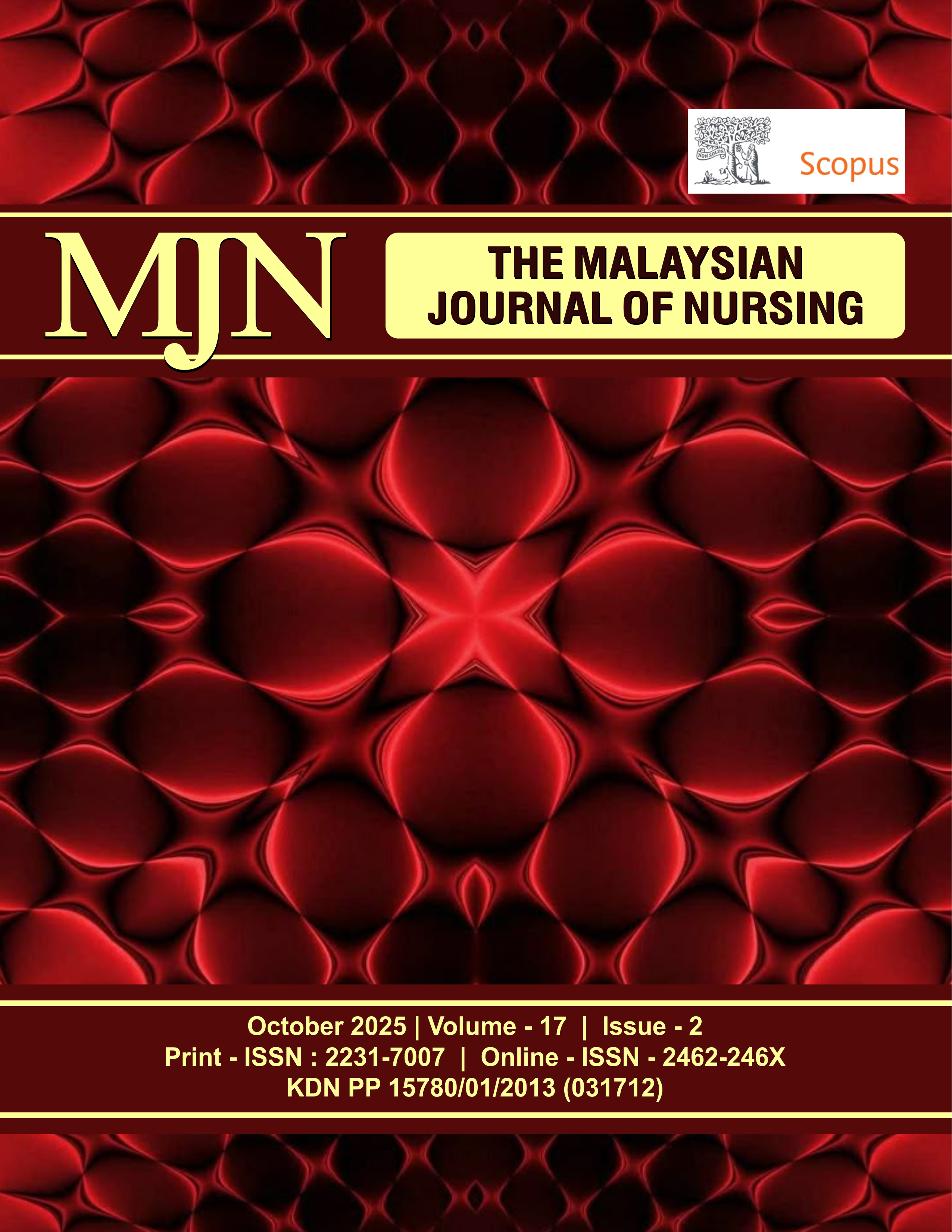Nurses’ Perceptions and Readiness to Use Virtual Reality Distraction in Paediatric Pain Management
DOI:
https://doi.org/10.31674/mjn.2025.v17i02.003Abstract
Background: Pain, among hospitalised children, is often undertreated, leading to negative physical and psychological outcomes. Virtual Reality Distraction (VRD) has emerged as an evidence-based, non-pharmacological method that is child-friendly and nurse-applicable. Objectives: This study explores nurses’ perceptions and readiness to use VRD as a strategy for paediatric pain management. Methods: A mixed-methods design was applied, combining a survey and focus group discussions (FGDs). The study was conducted in the paediatric ward of a government hospital in Bandung, Indonesia, between August and November 2023. A total of 40 nurses completed a 15-item readiness questionnaire, while 10 nurses participated in FGDs. Quantitative data was analysed using descriptive statistics, whereas qualitative data was examined using thematic analysis. Results: The findings indicated moderate readiness among nurses, with 52.6% scoring positively in both the cognitive and affective domains and 57.9% in behavioural readiness. Thematic analysis revealed five major themes regarding VRD: limited familiarity with its use, lack of integration into current nursing practice, age appropriateness of its application, the importance of age-specific content, and the need for structured training. While nurses recognised VRD as potentially effective, they emphasised practical considerations, such as training, infrastructure, and patient suitability. Conclusion: Nurses demonstrated moderate readiness and positive perceptions toward implementing VRD for paediatric pain management, highlighting its potential integration into routine care. However, readiness alone is insufficient; successful adoption requires addressing practical barriers such as staff training, age-appropriate content, and adequate infrastructure. Broader multi-site studies are recommended to validate these findings and support scalability. Hospitals should prioritise training, evidence-based guidelines, and interdisciplinary collaboration to establish VRD as an affordable, effective, and sustainable component of paediatric nursing practices.
Keywords:
Cognitive Readiness, Innovation Adoption, Non-Pharmacological Intervention, Nursing Technology, Qualitative ResearchDownloads
References
Amallia, I. R. (2020). Efektivitas Virtual Reality Terhadap Prosedur Venapunksi Pada Pasien Anak [Effectiveness of Virtual Reality on Venapuncture Procedures in Pediatric Patients]. Jurnal Ilmiah Keperawatan Orthopedi (JIKO), 4(1), 28-33. https://doi.org/10.46749/jiko.v4i1.37
Araiza-Alba, P., Keane, T., & Kaufman, J. (2022). Are we ready for virtual reality in K–12 classrooms?. Technology, Pedagogy and Education, 31(4), 471-491. https://doi.org/10.1080/1475939X.2022.2033307
Aydın, A. İ., & Özyazıcıoğlu, N. (2019). Using a virtual reality headset to decrease pain felt during a venipuncture procedure in children. Journal of PeriAnesthesia Nursing, 34(6), 1215-1221. https://doi.org/10.1016/j.jopan.2019.05.134
Bahrololoomi, Z., Zein Al-Din, J., Maghsoudi, N., & Sajedi, S. (2024). Efficacy of virtual reality distraction in reduction of pain and anxiety of pediatric dental patients in an iranian population: A split‐mouth randomized crossover clinical trial. International Journal of Dentistry, 2024(1), 1290410. https://doi.org/10.1155/2024/1290410
Bahrudin, M. (2017). Patofisiologi nyeri (pain). Saintika Medika, 13(1), 7-13. https://doi.org/10.22219/sm.v13i1.5449
Bexson, C., Oldham, G., & Wray, J. (2024). Safety of virtual reality use in children: A systematic review. European Journal of Pediatrics, 183(5), 2071-2090. https://doi.org/10.1007/s00431-024-05488-5
Brand, K., & Thorpe, B. (2016). Pain assessment in children. Anaesthesia & Intensive Care Medicine, 17(6), 270-273. https://doi.org/10.1016/j.mpaic.2016.03.007
Braun, V., & Clarke, V. (2006). Using thematic analysis in psychology. Qualitative Research in Psychology, 3(2), 77-101. https://uwe-repository.worktribe.com/index.php/preview/1043068/thematic_analysis_revised_-_final.pdf
Chen, J., Hu, J., Zhang, K., Zeng, X., Ma, Y., Lu, W., ... & Wang, G. (2024). Virtual reality enhances the social skills of children with autism spectrum disorder: A review. Interactive Learning Environments, 32(5), 2321-2342. https://doi.org/10.1080/10494820.2022.2146139
Dias, G. T. L. (2023). Pelatihan Telenursing untuk Meningkatka Kesiapan Perawat dalam Implementasi Telenursing dan Evaluasi Pelaksanaan Telenursing pada Pasien Pasca Rawat Inap [Telenursing Training to Improve Nurse Readiness in Telenursing Implementation and Evaluation of Telenursing Implementation in Post-Hospitalization Patients]. Jurnal Penelitian Kesehatan" SUARA FORIKES"(Journal of Health Research" Forikes Voice"), 14(4), 765-768. https://doi.org/10.33846/sf14420
Gao, Y., Xu, Y., Liu, N., & Fan, L. (2023). Effectiveness of virtual reality intervention on reducing the pain, anxiety and fear of needle‐related procedures in paediatric patients: A systematic review and meta‐analysis. Journal of Advanced Nursing, 79(1), 15-30. https://doi.org/10.1111/jan.15473
Guerra-Armas, J., Flores-Cortes, M., Pineda-Galan, C., Luque-Suarez, A., & La Touche, R. (2023). Role of immersive virtual reality in motor behaviour decision-making in chronic pain patients. Brain Sciences, 13(4), 617. https://doi.org/10.3390/brainsci13040617
Hua, Y., Qiu, R., Yao, W. Y., Zhang, Q., & Chen, X. L. (2015). The effect of virtual reality distraction on pain relief during dressing changes in children with chronic wounds on lower limbs. Pain Management Nursing, 16(5), 685-691. https://doi.org/10.1016/j.pmn.2015.03.001
Irmayanti, R., Malini, H., & Murni, D. (2019). Persepsi perawat tentang Evidence Based Nursing Practice (EBNP) di rumah sakit [Nurses' perceptions of Evidence Based Nursing Practice (EBNP) in hospitals]. Jurnal Endurance: Kajian Ilmiah Problema Kesehatan, 4(3), 516-529. https://doi.org/10.22216/jen.v4i3.4638
Jeong, S. Y. S., & Lee, K. O. (2019). The emergence of virtual reality simulation and its implications for nursing profession. Korean Journal of Women Health Nursing, 25(2), 125-128. https://doi.org/10.4069/kjwhn.2019.25.2.125
Jones, T., Moore, T., & Choo, J. (2016). The impact of virtual reality on chronic pain. PloS One, 11(12), e0167523. https://doi.org/10.1371/journal.pone.0167523
Khajehpour, S. H., Esfahani, M. S., & Yershov, D. (2024). VR in adult acute pain management – an exploration into the existing academic literature. Series on Technology Management, 153. https://doi.org/10.1142/9781800614192_0007
Lau, S. T., Siah, R. C. J., Dzakirin Bin Rusli, K., Loh, W. L., Yap, J. Y. G., Ang, E., ... & Liaw, S. Y. (2023). Design and evaluation of using head-mounted virtual reality for learning clinical procedures: Mixed methods study. JMIR Serious Games, 11, e46398. https://doi.org/10.2196/46398
Mirza, N., Manankil-Rankin, L., Prentice, D., Hagerman, L. A., & Draenos, C. (2019). Practice readiness of new nursing graduates: A concept analysis. Nurse Education in Practice, 37, 68-74. https://doi.org/10.1016/j.nepr.2019.04.009
Nurhanifah, D., & Sari, R. T. (2022). Manajemen nyeri nonfarmakologi [Nonpharmacological pain management]. UrbanGreen Central Media. https://book.urbangreen.co.id/index.php/urbangreen/catalog/book/12
Pinzon, R. T. (2016). Pengkajian nyeri [Pain assessment]. Betha Grafika, Yogyakarta. https://publikasi-fk.ukdw.ac.id/Buku_Pengkajian_Nyeri_Dr_Pinzon.pdf
Rahayu, H. S. (2020). Pemberian teknik distraksi pemutaran video kartun untuk menurunkan nyeri pada anak post operasi [Providing distraction techniques by playing cartoon videos to reduce pain in post-operative children]. JIKO (Jurnal Ilmiah Keperawatan Orthopedi), 4(1), 1-9. https://doi.org/10.46749/jiko.v4i1.34
Raman, R., & Sullivan, N. (2024). Integrating scholarly evidence and personal experience in health information technology-enabled evidence-based patient-care practices: Challenges, opportunities, and outcomes. ACM SIGMIS Database: the DATABASE for Advances in Information Systems, 55(1), 88-135. https://doi.org/10.1145/3645057.3645063
Rector, C., & Polivka, B.J. (2013). Evidence-based practice and ethics in community health nursing. In M. Stanhope & J. Lancaster (Eds.), Community and public health nursing: Promoting the public’s health (8th ed.), Elsevier.
Romualdo, J.M., Borges, E., Tavares, I., & Pozza, D.H. (2024). The interplay of fear of pain, emotional states, and pain perception in medical and nursing students: A cross-sectional study. PLoS One, 19(11), e0314094. https://doi.org/10.1371/journal.pone.0314094
Saraswati, E., & Hariyati, R. T. S. (2022). Virtual realitas dan pengalihan nyeri pada pasien kanker (Tinjauan Pustaka) [Virtual reality and pain distraction in cancer patients (Literature Review)]. Journal of Innovation Research and Knowledge, 1(8), 651-660. https://doi.org/10.53625/jirk.v1i8.1098
Saunders, H., & Vehviläinen-Julkunen, K. (2016). The state of readiness for evidence-based practice among nurses: An integrative review. International Journal of Nursing Studies, 56, 128-140. https://doi.org/10.1016/j.ijnurstu.2015.10.018
Shetty, V., Suresh, L. R., & Hegde, A. M. (2019). Effect of virtual reality distraction on pain and anxiety during dental treatment in 5- to 8-year-old children. Journal of Clinical Pediatric Dentistry, 43(2), 97-102. https://oss.jocpd.com/files/article/20220701-208/pdf/JOCPD43.2.5.pdf
Trudeau, A., Xie, Y., Ketsman, O., & Demir, F. (2023). “Breaking the fourth wall”: The effects of cinematic virtual reality film-viewing on adolescent students’ empathic responses. Computers & Education: X Reality, 2, 100009. https://doi.org/10.1016/j.cexr.2023.100009
Twamley, J., Hamer, O., Hill, J., Kenyon, R., Twamley, H., Casey, R., ... & Clegg, A. (2024). Exploring the perceptions of former ICU patients and clinical staff on barriers and facilitators to the implementation of virtual reality exposure therapy: a qualitative study. Nursing in Critical Care, 29(2), 313-324. https://doi.org/10.1111/nicc.12868
Ugras, G. A., Kanat, C., Yaman, Z., Yilmaz, M., & Turkmenoglu, M. O. (2023). The effects of virtual reality on preoperative anxiety in patients undergoing colorectal and abdominal wall surgery: a randomized controlled trial. Journal of Perianesthesia Nursing, 38(2), 277-283. https://doi.org/10.1016/j.jopan.2022.07.005
Wong, C. L., & Choi, K. C. (2023). Effects of an immersive virtual reality intervention on pain and anxiety among pediatric patients undergoing venipuncture: A randomized clinical trial. JAMA Network Open, 6(2), e230001-e230001. https://doi.org/10.1001/jamanetworkopen.2023.0001
Zale, E. L., Lange, K. L., Fields, S. A., & Ditre, J. W. (2013). The relation between pain-related fear and disability: a meta-analysis. The Journal of Pain, 14(10), 1019-1030. https://doi.org/10.1016/j.jpain.2013.05.005
Published
How to Cite
Issue
Section
License
Copyright (c) 2025 The Malaysian Journal of Nursing (MJN)

This work is licensed under a Creative Commons Attribution-NonCommercial-NoDerivatives 4.0 International License.



































